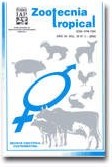
|
Zootecnia Tropical
Instituto Nacional de Investigaciones Agrícolas Venezuela
ISSN: 0798-7269
Vol. 21, No. 4, 2003, pp. 383-398
|
 Bioline Code: zt03024
Bioline Code: zt03024
Full paper language: English
Document type: Research Article
Document available free of charge
|
|
|
Zootecnia Tropical, Vol. 21, No. 4, 2003, pp. 383-398
| en |
Valuation of cottonseed meal in food of Nile tilapia ( Oreochromis niloticus  , L.) fingerlings , L.) fingerlings
Sandra Regina de Souza e Carmino Hayashi
Abstract
The experiment was carried out with the objective of evaluating the Nile tilapia fingerlings performance under different levels of cottonseed meal (CM) inclusion (0, 20, 40, 60 and 80%) with fiber and aminoacids correction. The experiment was carried out in the Laboratório de Aquicultura da Universidade Estadual de Maringá. Two hundred fifty fingerlings were used with an initial medium weight of 0.35 ± 0.07g, medium initial length of 2.95 ± 0.20cm, and an approximated age of 35 days. Fingerlings were divided in 25 tanks of 250 lt, in a completely randomized design with five treatments and five replications. The evaluated variables were weight gain (WG), feed gain (FG) , protein efficiency rate (PER), survival (S), hepatic-somatic index (HSI), condition factor (CF), protein in the carcass (PC), and fat in the carcass (FP). The WG and PER presented a linear decrease when the CM was included in the ration, as well FG and HSI. The S, DM, FC and CF did not show significant differences (P>0.05) among the treatments. It was concluded that cottonseed meal influenced in a negative way the fingerlings performance when the rations were supplemented with synthetic aminoacids.
Keywords
cotton meal, Nile tilapia, Oreochromis niloticus, performance.
|
| |
| pt |
Avaliação do farelo de algodão na alimentação de alevinos de tilápia do Nilo ( Oreochromis niloticus  L.) L.)
Sandra Regina de Souza e Carmino Hayashi
Resumo
O experimento foi conduzido com o objetivo de avaliar o desempenho dos alevinos de tilápia do Nilo submetidas a diferentes níveis de inclusão do farelo de algodão (FA) (00; 20; 40; 60 e 80%) com correção de fibra e aminoácidos. O experimento foi realizado no Laboratório de Aquicultura da Universidade Estadual de Maringá, utilizando-se 250 alevinos, com peso médio inicial de 0,35 ± 0,07g, comprimento inicial médio de 2,95 ± 0,20cm e idade aproximada de 35 dias, distribuídos em 25 tanques de 250L, num delineamento inteiramente casualizado com cinco tratamentos e cinco repetições. As variáveis avaliadas foram ganhas de peso (GP), conversão alimentar (CA), taxa de eficiência protéica (TEP), sobrevivência (SO), índice hepato-somático (IHS), fator de condição (FC), percentagem de proteína na carcaça (PC) e percentagem de gordura na carcaça (GC). O GP e a TEP apresentaram redução linear na medida em que o FA foi incluído nas rações, porém não houve diferença significativa entre o tratamento controle e os com 20 e 40% de inclusão. A CA e o IHS apresentaram aumento linear, e também não houve diferença significativa entre o tratamento controle e os com 20 e 40% de inclusão. A SO, MS, PC, GC e FC não apresentaram diferenças (P>0,05) significativas entre os diferentes tratamentos. Conclui-se que quando a dieta é suplementada com aminoácidos sintéticos é possível utilizar até 40% de inclusão de FA sem alterar de forma significativa o desempenho dos animais nesta fase de desenvolvimento.
Palavras-chave
desempenho, farelo de algodão, Oreochromis niloticus, tilápia do Nilo.
|
| |
© Copyright 2003 - Zootecnia Tropical
Alternative site location: http://www.sian.inia.gob.ve/repositorio/revistas_ci/ZootecniaTropical/ztindice.htm
|
|
